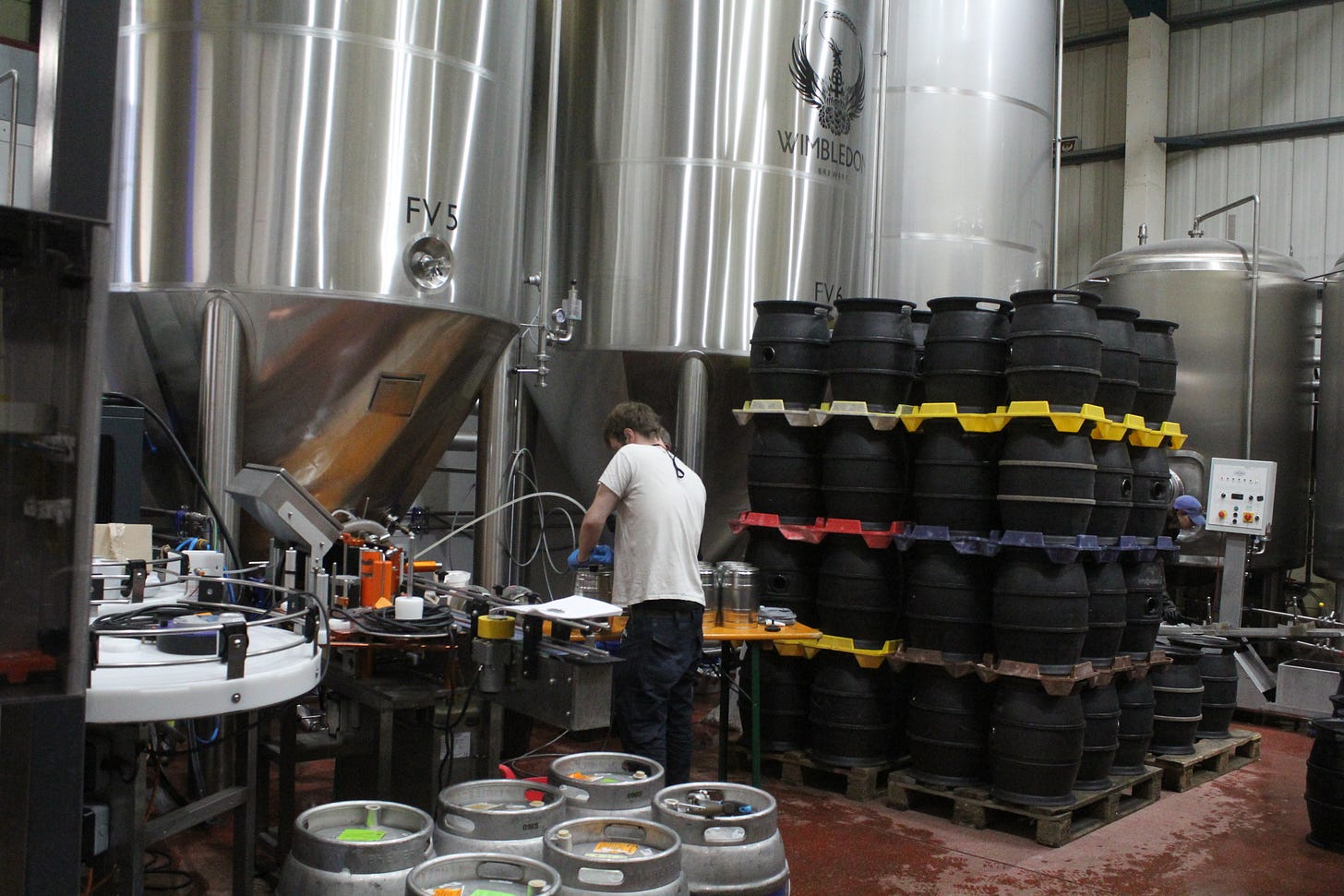The world of kegs, cans and gin: A day at the Wimbledon Brewery
I sat down with Simon Lewis and Oliver Bergassi to wax lyrical on everything from canned IPA to burnt down breweries.
Note: Welcome to the first of The Wimble’s features. I will be running a monthly / bi-monthly features section depending on our calendar! They’ll be released on Sundays, usually around 10:00 am, so you can have a lie in, wake up, make yourself a coffee and enjoy. Also, if you didn’t catch this week’s newsletter, you can read it here.
Beer is the vena cava of British recreation. It rears its head for most occasions, big or small: birthdays, funerals, matchdays, catch-ups, breakups, Christmas dinners, dreary school reunions. But how much do we know about the stuff? We may consume it like it’s 1999, but the process that goes into beer is as complex as wine. To find out more about the brewing industry and what it means to be a ‘local beer’, I headed off to the Wimbledon Brewery in search of answers.
A day at the brewery (03/06/2024):
I realise very quickly that there’s a lot to take in. I’ve only been here for five minutes and already I’ve met a brewer, had someone explain the difference between a pilsner and a lager, and learnt about the foundation of the business.
Simon Lewis, the brewery’s managing director, has had a long and successful career in the trade. He talks about joining the company when it first began, leaving for a short hiatus and then returning a few years later. Oli Bergassi, the sales manager for North and East London, whose job is all about getting the Wimbledon Brewery’s beer on pub taps, explains that it’s very important for the brewery to expand its horizons to other regions of London. He points at his bike as the two tell me that cycling to work is a big part of the brewery’s ethos.
The three of us are sitting on a bench. It's a pleasant day outside of the brewery — situated just off of Prince Georges Road in a complex of warehouses. The team have made the brewery look welcoming. The benches and decorations give it a sort of industrial beer garden feel. To my left is a mountain of kegs, each one full of beer and ready to be hoisted onto the back of the company’s van. These kegs will eventually be collected from the pubs that use them and reused to start the cycle again. Behind me is a flat screen television. Simon tells me they’ll be showing the Euros here.
The Wimbledon Brewery was set up in 2015 by Mark Gordon with help from Derek Prentice, a legend in the industry. Back then, it was exclusively brewing cask beer. It’s since expanded its list to include lagers, IPAs, pale ales, pilsners, gin, and even champagne. “If you had a brewery just producing cask beer now, it would feel a bit mad,” Simon laughs.
Simon tells me that the brewery had a meteoric rise almost immediately after its conception. They weren’t the only ones. In 2009, when Simon was making plans for a different business, he discovered that there were only five local breweries in London. There are over 120 now. “It was 126 a couple of years ago, but some breweries close and new ones open, so it’s roughly around that number,” says Oli.
Of course Covid — cue dramatic music — and its attendant pub closures slowed the growth of these local breweries. “After Covid, instead of supplying all of the big chains, we went back to independent pubs within the M25 area where 25% of all beer is drunk,” says Simon. That last statistic shocks me — I’d always imagined that London, though of course a metropolis, has enough teetotallers to lower its alcohol-drinking demographic. Apparently not. “We probably brew 60% of what we did at our peak, but in a way that gives us far more control and the ability to work with the top end of the pub trade.”
Covid also showed how important packaged beer was to them. Simon points towards the brewery. “We’ve invested in a canning line and now we can make the beer fresher because we’re doing it in smaller batches, straight from the tank and into the cans. Everything we make we package ourselves. It’s all about targeting the freshness and quality of the beer.”
The Wimbledon Brewery logo sits proudly behind us. What’s the story behind that, I ask him. “There was a brewery in the 1880s and it burnt down. The idea with our logo is that you’ve got the phoenix rising from the flames of the brewery. You’ve got the tower — that’s what the old brewery looked like — with the phoenix atop a mound of hops. The logo is a reference to the fact that, like most places across London, there would have been a local brewery in Wimbledon at some time.”
I tell them I’m a sucker for independent pubs, no matter how expensive they can be. “Knowing where your beer is from and being able to to follow it through from a quality perspective is really important,” Simon agrees.

I ask Simon what he enjoys most about being here. “My favourite bit of the job,” says Simon, “is doing the brewery tours. You’ve got 20 people and you’re going around and you’re pouring a drink straight out of the tank as fresh as they’re ever going to get it.” These tours are useful in the sense that the visitors can taste the beer at its best — when a beer tastes bad at the pub, it often has more to do with the lines and how they’ve stored it than the product itself.
What does an average week look like here? “You start Monday with no sales, pretty much. You get a bunch of orders on the weekend but that’s all on email and WhatsApp,” says Simon. “So there is no way of genuinely predicting what sales will be like. With the Wimbledon [championship] fortnight, I can tell you that we will grow sales over the next month or so. But to sit there and predict how many tubs we’ll sell next week is impossible.”
The two of them take me on a tour of the brewery itself. The space is impressive, but the aluminium tanks are the real showstoppers, where a small team of brewers work at speed to deliver the highest quality beer possible. Then there’s the smell. For a short and strange period of my life, I worked for a microbrewery in Devon. Though it came with its drawbacks — drinking our own supply, late nights, stained clothes —being reunited with the smell of hops and spilt beer is a welcome treat.
There’s something exciting about being in a brewery. It’s where science and creativity merge. A small part of me wants to throw my hat in the ring and get involved, though I’d need years of specialist training first. If you haven’t tried any of Wimbledon’s beers, you’re missing out. That goes for their gin, too. I had some last week and it went down incredibly smoothly — perhaps a little too smoothly.
We finish the meeting outside. My head is a little clustered; I’ve been given a masterclass in beer production in under an hour. I shake hands with Simon and Oli before the two go back to a day of intense work. Running and working in a local brewery is incredibly exciting and incredibly stressful, and it’s not for the fainthearted. I start the long walk back to Wimbledon Village with one thought in mind: I fancy a pint.






